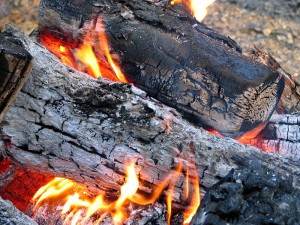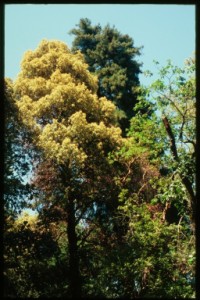On November 18, Ohio authorities and APHIS announced the discovery of Asian longhorned beetle- infested trees in a section of Clermont County previously thought to be free of the insect. (The press release is not yet posted to the web; go here to see the most recent information).
The center of the newly discovered infestation is within the Williamsburg Township portion of the East Fork Wildlife Area, south of Clover Road. Tree inspection crews will continue to survey the area to determine the extent of the infestation. Any trees found to be infested will be removed as part of the eradication effort. Also, authorities will expand the ALB quarantine to include areas near the new infestation. When available, a map of the regulated areas will be posted at agri.ohio.gov.
This setback reminds us how difficult it is to contain or eradicate this insect.
ALB was first discovered in Tate Township in Clermont County, Ohio, in June 2011. That quarantine currently covers a 61-square miles area. According to the October 28 APHIS electronic newsletter, more than 2 million trees in the quarantine zone have been surveyed. The survey has detected 18,614 infested trees since 2011. 87,151 trees have been removed; Of these, 17,995 were infested and 69,156 were deemed at high-risk of either already being infested or likely to become infested in the immediate future.
Status of ALB in Other States
Massachusetts ALB was first detected in Worcester in 2008. The quarantine covers 110 square miles. At least 35,870 trees have been removed in the Commonwealth.
New York ALB was first detected in Queens in August 1996. APHIS and the state continue efforts to eradicate ALB from three separate infestations in Queens, Brooklyn, and Amityville. The quarantine covers a total of 137 square miles. The number of infested Trees for the entire New York program is 7,082. The number of trees removed is 23,731. Outbreaks in several sites have been declared eradicated:
- Islip (Suffolk County) in 2011;
- Manhattan and Staten Island in 2013.
In 2013, the Amityville area infestation was found to be larger than previously known.
The total number of trees removed in the Massachusetts, New York, and Ohio programs was 146,000. However, this is not the total for all the damage caused by the Asian longhorned beetle.
ALB outbreaks in Illinois (Chicago) and New Jersey were eradicated earlier, and their removals are not included in the total given above.
In Illinois, according to Haack et al. 2012, 1,771 trees were removed and 286,227 were treated with systemic pesticides (imidacloprid).
In New Jersey (again, according to Haack et al. 2009, 21,981 infested and high-risk trees were removed. Another 480,574 trees were treated. This total is not complete since the program had not yet succeeded in eradicating the ALB in New Jersey at the time of writing.
The total from all programs is 169,752.
The risk of new introductions remains.
- During fiscal years 2010 – 2016, Customs (CBP) detected tree-killing pests in 4,984 shipments – an average of 807 shipments each year. (For the 2015 report, go here)
- An analysis by Haack et al. (2014) concluded that one tenth of one percent of the wood packaging entering the U.S. after adoption of ISPM#15 still contained a tree-killing pest. Since the U.S. imports approximately 25 million shipping containers each year, and about half of these contain wood packaging, an “approach rate” of 0.1% equals 13,000 containers harboring pests that probably enter the country each year. That is 35 potential pest arrivals per day.
- Customs send samples of intercepted wood packaging to an APHIS laboratory where the insect larvae are grown to adulthood and identified. The APHIS lab has received 1,068 insects from April 2012 through August 2016, taken from 786 separate interceptions of non-compliant wood packaging. Six of the insects were Asian longhorned beetles.
APHIS also detected 69 other pests in wood packaging sent from China.
The United States and Canada began requiring wood packaging from China to be treated in December 1998. (See my discussion of this regulation in Fading Forests II here. Since the Customs data begin in 2010, we can see that 11 to 16 years after the rule governing Chinese wood packaging went into effect, we are still receiving wood packaging with pests from that country.
Also, 700 pests arrived from 36 other countries, led by Mexico, Turkey, and Ukraine (see presentation here; search for “Nadel”)
What are APHIS & CBP doing about these flagrant violations of existing rules? Each violation exposes our forests to additional pest attack and our citizens to higher costs – either in local or federal taxes or personal costs to remove trees — as well as to mental anguish and health impacts.
The evidence is in. APHIS and Customs should tighten enforcement of ISPM#15 by:
- Prohibiting imports in solid wood packaging (boards) from foreign suppliers which have a record of repeated violations over the 10 years ISPM#15 has been in effect. (It’s been 16 years for exporters from Hong Kong and mainland China). A reasonable number of violations should trigger this prohibition – perhaps eight over the entire period.
The U.S. should allow imports from those suppliers that are contained in other types of packaging materials, including plastic, metals, fiberboards …
- Fining an importer for each new shipment found to be out of compliance with ISPM#15 if the foreign supplier of that shipment has a record of repeated violations (but fewer than the number that would trigger a ban) over the 10 years ISPM#15 has been in effect (16 years for exporters from Hong Kong & mainland China). The number of violations needed to trigger the fine might be five over the entire period – not just in one year.
- Ensuring that exporting countries understand that foreign suppliers that change their names or take other steps to obscure their past import records will be prosecuted for fraud. This penalty should be severe so as to deter deliberate attempts to avoid the consequences of past actions.
References
Haack, R.A., F. Herard, J. Sun, J.J. Turgeon. 2009. Managing Invasive Populations of Asian Longhorned Beetle and Citrus Longhorned Beetle: A Worldwide Perspective. Annu. Rev. Entomol. 2010. 55:521-46.
Haack, R. A., K. O. Britton, E. G. Brockerhoff, J. F. Cavey, L. J. Garrett, M. Kimberley, F. Lowenstein, A. Nuding, L. J. Olson, J. Turner, and K. N. Vasilaky. 2014. Effectiveness of the international phytosanitary standard ISPM no. 15 on reducing wood borer infestation rates in wood packaging material entering the United States. Plos One 9:e96611.
Posted by Faith Campbell


